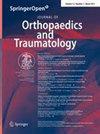使用骨性增大偏移(BIO-RSA)或增大盂状组件直径的侧向化反肩关节置换术:配对队列中临床、放射学和患者报告结果的比较
IF 3.7
2区 医学
Q1 ORTHOPEDICS
引用次数: 0
摘要
本研究旨在比较使用标准38毫米(mm)组件的骨性增加偏移侧向反向肩关节置换术(BIO-RSA)与使用42毫米盂组件的常规侧向反向肩关节置换术(RSA)的运动范围(ROM)。次要目的是比较两组患者的患者报告和放射学结果。对所有使用 BIO-RSA 和 38 号盂成形组件的患者进行回顾性鉴定,并与使用普通 RSA 和 42 号盂成形组件的患者进行配对。配对患者被邀请进行随访。对患者的活动度、影像学结果(侧化、远端化、下悬、肩胛骨切迹、异位骨形成、放射性、应力屏蔽、植骨愈合和存活率以及并发症)和患者报告结果(肩部主观价值、Constant评分、美国肩肘外科医生评分、需要内旋的日常生活活动、需要外旋的日常生活活动以及疼痛视觉模拟量表)进行评估。两组结果进行了比较。共有 38 例采用 38 号关节囊的 BIO-RSA 与 38 例采用 42 号关节囊的普通 RSA 进行了配对。在 76 名配对患者中,有 74 人可以联系上,其中 70 人(95%)被纳入配对。在最后的随访中,两组患者在ROM、患者报告结果或放射学结果方面均无差异(P > 0.485)。在侧位RSA中,使用较大的关节囊是BIO-RSA的可行替代方案,可提供相似的ROM、患者报告结果和影像学结果,同时可能降低成本、手术时间和并发症发生率。证据等级 III。本文章由计算机程序翻译,如有差异,请以英文原文为准。
Lateralising reverse shoulder arthroplasty using bony increased offset (BIO-RSA) or increasing glenoid component diameter: comparison of clinical, radiographic and patient reported outcomes in a matched cohort
This study aims to compare the range of motion (ROM) of reverse shoulder arthroplasty lateralised by bony increased offset (BIO-RSA) using a standard 38-mm (mm) component to regular reverse shoulder arthroplasty (RSA) lateralised by using a 42-mm glenoid component. The secondary aims are to compare patient-reported and radiographic outcomes between the two groups. All patients with a BIO-RSA and size 38 glenosphere were retrospectively identified and matched to patients with a regular RSA and size 42 glenosphere. Matched patients were invited for a follow-up visit. ROM was assessed as well as radiographic outcomes (lateralisation, distalisation, inferior overhang, scapular notching, heterotopic bone formation, radiolucency, stress shielding, bone graft healing and viability and complications) and patient-reported outcomes (subjective shoulder value, Constant score, American Shoulder and Elbow Surgeons, activities of daily living which require internal rotation, activities of daily living which require external rotation and a visual analogue scale for pain). Outcomes were compared between the two groups. In total, 38 BIO-RSAs with a size 38 glenosphere were matched to 38 regular RSAs with a size 42 glenosphere. Of the 76 matched patients, 74 could be contacted and 70 (95%) were included. At the final follow-up, there were no differences between the two groups in ROM, patient-reported outcomes or radiographic outcomes (p > 0.485). Using a larger glenosphere is a feasible alternative to BIO-RSA for lateralising RSA, providing comparable ROM, patient-reported and radiographic results, while potentially decreasing costs, operative time and complication rates. Level of evidence III.
求助全文
通过发布文献求助,成功后即可免费获取论文全文。
去求助
来源期刊

Journal of Orthopaedics and Traumatology
Medicine-Orthopedics and Sports Medicine
CiteScore
4.30
自引率
0.00%
发文量
56
审稿时长
13 weeks
期刊介绍:
The Journal of Orthopaedics and Traumatology, the official open access peer-reviewed journal of the Italian Society of Orthopaedics and Traumatology, publishes original papers reporting basic or clinical research in the field of orthopaedic and traumatologic surgery, as well as systematic reviews, brief communications, case reports and letters to the Editor. Narrative instructional reviews and commentaries to original articles may be commissioned by Editors from eminent colleagues. The Journal of Orthopaedics and Traumatology aims to be an international forum for the communication and exchange of ideas concerning the various aspects of orthopaedics and musculoskeletal trauma.
 求助内容:
求助内容: 应助结果提醒方式:
应助结果提醒方式:


